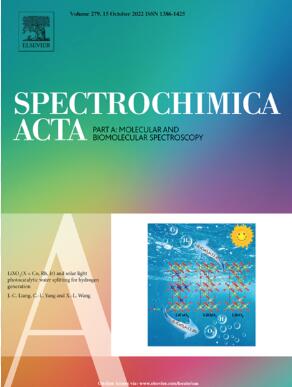The controllable fabrication of AIE gold nanoclusters and utilizing as portable ultrasensitive detection sensor for silver ions via smartphone
IF 4.3
2区 化学
Q1 SPECTROSCOPY
Spectrochimica Acta Part A: Molecular and Biomolecular Spectroscopy
Pub Date : 2025-02-05
DOI:10.1016/j.saa.2025.125862
引用次数: 0
Abstract
Heavy metal pollution is life-threatening, the detection of heavy metals is crucial to human health and environment. In this work, AIE featured LA-stabilized gold nanoclusters (NL-AuNCs) were designed and fabricated by modulating precursors in various reaction conditions, and utilized as an efficient fluorescent sensor for portable detecting Ag+ with high sensitivity and selectivity. The NL-AuNCs exhibited intense red fluorescence at 625 nm via the secondary reducing agent N-acetyl-L-cysteine (NAC), achieving a quantum yield (QY) of 15.7 %. Notably, the introduction of Ag+ enhanced the red fluorescence intensity of NL-AuNCs on account of the aggregation-induced emission (AIE) process, rendering NL-AuNCs uniquely capable of detecting Ag+ with the ultralow detection limit of 1.3 nM within a wide concentration range of 0.002–200 μM. Furthermore, the handheld intelligent sensing strategy was constructed by integrating the smartphone App, which enabled swift portable monitoring and convenient readout by visual assessment of color evolution. The acceptable recoveries of 94.6 % to 114.9 % were attained from testing real water, indicating the excellent environmental tolerance of NL-AuNCs, which allowed the possibility for practical in-situ detection.

求助全文
约1分钟内获得全文
求助全文
来源期刊
CiteScore
8.40
自引率
11.40%
发文量
1364
审稿时长
40 days
期刊介绍:
Spectrochimica Acta, Part A: Molecular and Biomolecular Spectroscopy (SAA) is an interdisciplinary journal which spans from basic to applied aspects of optical spectroscopy in chemistry, medicine, biology, and materials science.
The journal publishes original scientific papers that feature high-quality spectroscopic data and analysis. From the broad range of optical spectroscopies, the emphasis is on electronic, vibrational or rotational spectra of molecules, rather than on spectroscopy based on magnetic moments.
Criteria for publication in SAA are novelty, uniqueness, and outstanding quality. Routine applications of spectroscopic techniques and computational methods are not appropriate.
Topics of particular interest of Spectrochimica Acta Part A include, but are not limited to:
Spectroscopy and dynamics of bioanalytical, biomedical, environmental, and atmospheric sciences,
Novel experimental techniques or instrumentation for molecular spectroscopy,
Novel theoretical and computational methods,
Novel applications in photochemistry and photobiology,
Novel interpretational approaches as well as advances in data analysis based on electronic or vibrational spectroscopy.
文献相关原料
公司名称
产品信息
阿拉丁
DL-lipoic acid
阿拉丁
N-acetyl-L-cysteine

 求助内容:
求助内容: 应助结果提醒方式:
应助结果提醒方式:


